Exploring the Application of Smart City Concepts in New Town Development: A Case Study of Zhongyang Road, Hsinchu City, Taiwan
Abstract
1. Introduction
1.1. Research Background
1.2. Research Motivation
1.3. Research Objectives and Scope
1.4. Research Methodology
2. Literature Review
2.1. Smart Cities
2.1.1. Overview of Smart Cities
- Infrastructure: Includes autonomous vehicles, shared mobility solutions, and smart traffic signals integrated with real-time information systems [14]. Energy aspects involve renewable energy sources, smart grids, and energy-efficient buildings [15]. Communication infrastructure relies on 5G and IoT to handle massive data streams.
- Urban Management: Involves e-government services, digital identity frameworks, and integrated data platforms to enhance decision-making and public service quality [16]. Environmental monitoring uses sensors for air, water, and noise levels, while smart waste management and carbon-reduction measures bolster urban resilience.
- Smart Living: Enhances healthcare, education, and social services through telemedicine, online learning, and smart elderly care, making technology more accessible in daily life. Smart economies foster innovation through entrepreneurship support, shared economy platforms, and fintech, fueling urban transformation.
- Smart Society: Emphasizes citizen participation and digital inclusion, ensuring equitable access to smart technologies across all demographic groups [17]. Public safety and disaster preparedness are enhanced via smart policing, surveillance, risk detection, and cybersecurity measures.
- Urban Mobility: Real-time navigation and smart parking systems improve traffic flow and green mobility supports public transit and electric vehicles for low-carbon transition. Supporting technologies—IoT, AI, and blockchain—provide data collection, analysis, and security support.
2.1.2. Key Success Factors in Smart City Implementation
- Citizen-Centered Design: Smart city design should begin with addressing citizens’ real needs—improving convenience, safety, and sustainability [18].
- Data Governance and Privacy: As urban data scale grows, policies must ensure data security, privacy protection, and prevent misuse or leakage.
- Infrastructure Upgrades: Legacy systems—including power, transport, and communication networks—must be modernized to support digital and intelligent services.
- Policy and Regulatory Support: Governments must establish data-sharing, standardization, and privacy regulations to guide smart city development.
- Public–Private Partnerships (PPP): Collaboration between the government and private sector accelerates deployment by combining technical capacity and financial resources.
- G. Citizen Education and Engagement: Increasing public understanding and acceptance through outreach and participatory activities is critical.
- H. Sustainability Focus: Smart cities must balance economic, social, and environmental needs, with goals including resource efficiency, emissions reduction, and long-term resilience development.
2.1.3. Challenges in Smart City Development
- Funding Constraints: High initial costs may burden municipal budgets, with challenges in securing private investment and ensuring return on investment.
- Technology Monopolies: Dependence on single vendors can limit openness and interoperability.
- Digital Divide: Vulnerable groups—such as seniors, low-income residents, and remote communities—may be excluded from service equity.
- Data Security and Privacy: Large-scale data collection heightens privacy risk and vulnerability to cyberattacks.
- Coordination Barriers: Fragmented departmental systems and poor data sharing impede collaboration across agencies.
- Rapid Technological Obsolescence: High turnover of new technologies risks rendering solutions outdated quickly.
- Cultural and Social Resistance: Skepticism or reluctance to adopt new technologies may slow implementation.
2.1.4. Smart City Development Trends
- Digital Twin Technology: Virtual city modeling for simulation and optimization improves planning efficiency.
- Carbon Neutrality Goals: Smart cities aim to reduce emissions through energy optimization and low-carbon technologies.
- Integrated Smart Services: Moving from siloed functions (e.g., transport) toward holistic smart services.
- Enhanced Citizen Participation: Blockchain-based systems support transparent civic engagement and governance.
- Global Collaboration and Standardization: International knowledge-sharing and harmonized standards accelerate global adoption.
2.2. New Town Development
- Transport and Mobility: Multi-tier road networks and public transit (metro, light rail, buses), bicycle, and pedestrian pathways to support low-carbon mobility. Smart technologies such as real-time navigation and signal optimization enhance overall traffic efficiency.
- Housing and Community: Diverse housing options to accommodate multiple income groups, integrated with schools, healthcare, retail, and green spaces to foster cohesive neighborhoods.
- Economic and Industrial Planning: Defining core urban functions and promoting industry diversification—including high-tech, creative, and service sectors—to balance employment and living needs. Green infrastructure, renewable energy, energy-efficient buildings, and waste management are essential for sustainable land use.
- Social and Cultural Planning: Preservation of local heritage, provision of cultural institutions (e.g., museums, libraries), and inclusive amenities for all age groups. High-quality educational and healthcare infrastructures are foundational.
- Smart and Innovative Technology: Incorporation of smart transportation, energy management, e-government, and digital community platforms supported by big data and IoT. Financial planning includes public funding, PPPs, and cost-control mechanisms to ensure fiscal discipline.
- Regulations and Governance: Clear land-use policies and planning regulations, cross-department coordination, flexible future adaptation, risk-mitigation strategies, and public engagement are fundamental for sustainable acceptance [23].
2.3. Linking Smart Cities and New Town Development
2.4. Implementation Strategies for Applying Smart City Concepts in New Town Development
2.5. Theoretical Foundations and Evaluation Models
2.5.1. Systematic Evaluation Frameworks
2.5.2. Smart City Maturity Index (SCMI)
2.5.3. Composite Key Performance Indicator (CKPI)
3. Research Design
3.1. Research Scope
3.2. Current Condition Analysis
3.3. SWOT Analysis
- Strengths: Advantageous geographical location near the science park; stable population and industrial base; high public acceptance of smart technologies; proactive government resource support.
- Weaknesses: Aging infrastructure; uneven spatial distribution; insufficient public services and traffic management functions; low integration of smart construction.
- Opportunities: National policies promoting smart cities; mature technologies such as 5G and IoT; potential for simultaneous smart infrastructure implementation alongside urban renewal [35].
- Threats: Intense competition for resources; limited policy execution efficiency; high initial costs of smart infrastructure; public participation and social consensus yet to be fully established.
| Category | Internal/External Factors | Details |
|---|---|---|
| Strengths | Geographic and Policy |
|
| Social |
| |
| Infrastructure |
| |
| Weaknesses | Infrastructure |
|
| Transportation |
| |
| Social and Services |
| |
| Environment |
| |
| Opportunities | Policy and Technology |
|
| Economic |
| |
| Environment and Sustainability |
| |
| Threats | Financial |
|
| Social |
| |
| Environmental |
|
3.4. Application of Mathematical Models for Smart City Transformation Assessment
4. Research Results
4.1. Benefits of Smart City Applications on Zhongyang Road, Hsinchu
4.2. Cost and Benefit Analysis
4.3. Innovative Transformation Plan
- SCMI Average Delay Time (Equation (1)): Used to measure the effectiveness of proposed interventions in accelerating smart city development, and serves as a comparative metric among different planning strategies.
- CKPI for Renewable Energy Substitution (Equation (2)): Evaluates the actual substitution effect of applying renewable energy in public lighting scenarios, representing a quantifiable performance indicator for green energy implementation.
4.4. Feasibility of Smart City Transformation on Zhongyang Road, Hsinchu
- Policy Support: Taiwan’s national and local governments actively promote smart city programs, providing funding mechanisms, regulatory frameworks, and pilot projects that support the integration of ICT-based urban systems. This policy environment ensures institutional backing for implementation.
- Demographic Readiness: Hsinchu’s population, strongly linked to the high-tech industry, shows high acceptance of new digital services and strong adaptability to innovation. This demographic advantage facilitates citizen engagement and accelerates adoption of smart solutions.
4.5. Discussion
5. Conclusions and Recommendations
5.1. Research Conclusions
5.2. Policy Recommendations
- Strategic Roadmaps—Establish phased implementation strategies that integrate smart city development with urban renewal policies.
- Data Governance and Security—Develop robust regulations for data sharing, privacy protection, and cybersecurity to build public trust.
- Public–Private Partnerships (PPP)—Encourage cross-sector collaboration to share infrastructure costs, promote innovative applications, and accelerate deployment.
5.3. Future Research Directions
Author Contributions
Funding
Data Availability Statement
Acknowledgments
Conflicts of Interest
References
- Caragliu, A.; Del Bo, C.; Nijkamp, P. Smart Cities in Europe. J. Urban Technol. 2011, 18, 65–82. [Google Scholar] [CrossRef]
- Batty, M.; Axhausen, K.W.; Giannotti, F.; Pozdnoukhov, A.; Bazzani, A.; Wachowicz, M.; Ouzounis, G.; Portugali, Y. Smart cities of the future. Eur. Phys. J. Spec. Top. 2012, 214, 481–518. [Google Scholar] [CrossRef]
- Giffinger, R.; Fertner, C.; Kramar, H.; Kalasek, R.; Pichler-Milanović, N.; Meijers, E. Smart Cities. Ranking of European Medium-Sized Cities. Cent. Reg. Sci. Vienna Univ. Technol. 2007. [Google Scholar] [CrossRef]
- Komninos, N. The Architecture of Intelligent Cities: Integrating human, collective and artificial intelligence to enhance knowledge and innovation. In Proceedings of the 2nd IET International Conference on Intelligent Environments—IE 06, Athens, Greece, 5–6 July 2006; pp. 13–20. [Google Scholar]
- Cocchia, A. Smart and Digital City: A Systematic Literature Review. In Smart City: How to Create Public and Economic Value with High Technology in Urban Space; Dameri, R.P., Rosenthal-Sabroux, C., Eds.; Springer International Publishing: Cham, Germany, 2014; pp. 13–43. [Google Scholar] [CrossRef]
- Hsu, W.-L.; Lu, Y.; Xu, H.; Qiao, M.; Sun, K.-S. Evaluation System of Green Smart City. Sens. Mater. 2024, 36, 2909–2924. [Google Scholar] [CrossRef]
- Townsend, A.M. Smart Cities: Big Data, Civic Hackers, and the Quest for a New Utopia; W. W. Norton & Company: New York, NY, USA, 2013. [Google Scholar]
- Chourabi, H.; Nam, T.; Walker, S.; Gil-Garcia, J.R.; Mellouli, S.; Nahon, K.; Pardo, T.A.; Scholl, H.J. Understanding Smart Cities: An Integrative Framework. In Proceedings of the 2012 45th Hawaii International Conference on System Sciences, Maui, HI, USA, 4–7 January 2012; pp. 2289–2297. [Google Scholar]
- Lee, J.H.; Phaal, R.; Lee, S.-H. An integrated service-device-technology roadmap for smart city development. Technol. Forecast. Soc. Change 2013, 80, 286–306. [Google Scholar] [CrossRef]
- Mora, L.; Deakin, M.; Reid, A. Strategic principles for smart city development: A multiple case study analysis of European best practices. Technol. Forecast. Soc. Change 2019, 142, 70–97. [Google Scholar] [CrossRef]
- Albino, V.; Berardi, U.; Dangelico, R.M. Smart Cities: Definitions, Dimensions, Performance, and Initiatives. J. Urban Technol. 2015, 22, 3–21. [Google Scholar] [CrossRef]
- Shahrabani, M.M.; Apanaviciene, R. Evaluation of Smart Building Integration into a Smart City by Applying Machine Learning Techniques. Buildings 2025, 15, 2031. [Google Scholar] [CrossRef]
- Velasquez Mendez, A.; Lozoya Santos, J.; Jimenez Vargas, J.F. Strategic Socio-Technical Innovation in Urban Living Labs: A Framework for Smart City Evolution. Smart Cities 2025, 8, 131. [Google Scholar] [CrossRef]
- Liu, M.; Li, Y.; Liu, X.; Chen, Y.; Hao, R. An Integrated Optimization Framework for Connected and Automated Vehicles and Traffic Signals in Urban Networks. Systems 2025, 13, 224. [Google Scholar] [CrossRef]
- Dadzie, J.; Runeson, G.; Ding, G.; Bondinuba, F.K. Barriers to Adoption of Sustainable Technologies for Energy-Efficient Building Upgrade—Semi-Structured Interviews. Buildings 2018, 8, 57. [Google Scholar] [CrossRef]
- Tang, Y.; Fu, H.; Xu, B. Advanced design of triboelectric nanogenerators for future eco-smart cities. Adv. Compos. Hybrid Mater. 2024, 7, 102. [Google Scholar] [CrossRef]
- Zhu, J.; Gianoli, A.; Noori, N.; de Jong, M.; Edelenbos, J. How different can smart cities be? A typology of smart cities in China. Cities 2024, 149, 104992. [Google Scholar] [CrossRef]
- Cavada, M.; Kwon, N.; Cooper, R. Designing the Urban Smart Futures Agenda for Lancaster, UK. Urban Sci. 2024, 8, 174. [Google Scholar] [CrossRef]
- Allam, Z.; Newman, P. Redefining the Smart City: Culture, Metabolism and Governance. Smart Cities 2018, 1, 4–25. [Google Scholar] [CrossRef]
- Hsu, W.-L.; Qiao, M.; Xu, H.; Zhang, C.; Liu, H.-L.; Shiau, Y.-C. Smart City Governance Evaluation in the Era of Internet of Things: An Empirical Analysis of Jiangsu, China. Sustainability 2021, 13, 13606. [Google Scholar] [CrossRef]
- Zygiaris, S. Smart City Reference Model: Assisting Planners to Conceptualize the Building of Smart City Innovation Ecosystems. J. Knowl. Econ. 2013, 4, 217–231. [Google Scholar] [CrossRef]
- Chen, C.; Liu, H.; Wang, Z. Analysis and Design of Urban Traffic Congestion in Urban Intelligent Transportation System Based on Big Data and Internet of Things. In Proceedings of the 2019 International Conference on Artificial Intelligence and Computer Science, Wuhan, China, 12–13 July 2019; pp. 659–665. [Google Scholar] [CrossRef]
- Yigitcanlar, T.; Kamruzzaman, M. Does smart city policy lead to sustainability of cities? Land Use Policy 2018, 73, 49–58. [Google Scholar] [CrossRef]
- Mahmud, S.; Day, C.M. Chapter 23—Leveraging data-driven traffic management in smart cities: Datasets for highway traffic monitoring. In The Rise of Smart Cities; Alavi, A.H., Feng, M.Q., Jiao, P., Sharif-Khodaei, Z., Eds.; Butterworth-Heinemann: Oxford, UK, 2022; pp. 583–607. [Google Scholar] [CrossRef]
- Zhu, J.; Xie, N.; Cai, Z.; Tang, W.; Chen, X. A comprehensive review of shared mobility for sustainable transportation systems. Int. J. Sustain. Transp. 2023, 17, 527–551. [Google Scholar] [CrossRef]
- Neirotti, P.; De Marco, A.; Cagliano, A.C.; Mangano, G.; Scorrano, F. Current trends in Smart City initiatives: Some stylised facts. Cities 2014, 38, 25–36. [Google Scholar] [CrossRef]
- McArthur, J.J.; Jofeh, C.G.H. Portfolio retrofit evaluation: A methodology for optimizing a large number of building retrofits to achieve triple-bottom-line objectives. Sustain. Cities Soc. 2016, 27, 263–274. [Google Scholar] [CrossRef]
- Bibri, S.E. The IoT for smart sustainable cities of the future: An analytical framework for sensor-based big data applications for environmental sustainability. Sustain. Cities Soc. 2018, 38, 230–253. [Google Scholar] [CrossRef]
- Tan, K.L.; Poddar, S.; Sarkar, S.; Sharma, A. Deep Reinforcement Learning for Adaptive Traffic Signal Control. arXiv 2019, arXiv:1911.06294. [Google Scholar] [CrossRef]
- ISO 37122; Sustainable cities and communities—Indicators for smart cities. International Organization for Standardization: Vernier, Switzerland, 2019.
- Anthopoulos, L.G. Understanding the smart city domain: A literature review. In Transforming Government: People, Process and Policy; Reddick, C.G., Ed.; Springer: Cham, Switzerland, 2015; Volume 9, pp. 9–21. [Google Scholar] [CrossRef]
- Nam, T.; Pardo, T.A. Conceptualizing smart city with dimensions of technology, people, and institutions. In Proceedings of the 12th Annual International Digital Government Research Conference: Digital Government Innovation in Challenging Times, College Park, MD, USA, 12–15 June 2011; pp. 282–291. [Google Scholar]
- Kitchin, R. The real-time city? Big data and smart urbanism. GeoJournal 2014, 79, 1–14. [Google Scholar] [CrossRef]
- Hsin chu City Map. Interactive map. Google Maps. Available online: https://www.google.com/maps (accessed on 1 August 2025).
- Hashem, I.A.T.; Chang, V.; Anuar, N.B.; Adewole, K.; Yaqoob, I.; Gani, A.; Ahmed, E.; Chiroma, H. The role of big data in smart city. Int. J. Inf. Manag. 2016, 36, 748–758. [Google Scholar] [CrossRef]
- Angelidou, M. Smart city policies: A spatial approach. Cities 2014, 41, S3–S11. [Google Scholar] [CrossRef]
- Simms, C.; Trott, P.; Hende, E.v.d.; Hultink, E.J. Barriers to the adoption of waste-reducing eco-innovations in the packaged food sector: A study in the UK and the Netherlands. J. Clean. Prod. 2020, 244, 118792. [Google Scholar] [CrossRef]
- Shi, W.; Cui, Y.; Li, W.; Cai, G.; Qian, Y. Cultivating empathy and upgrading design decisions of students: The impact of simulating public transit experiences of individuals with mild visual impairments. Int. J. Technol. Des. Educ. 2025, 35, 1571–1595. [Google Scholar] [CrossRef]
- Melikoglu, M. Pumped hydroelectric energy storage: Analysing global development and assessing potential applications in Turkey based on Vision 2023 hydroelectricity wind and solar energy targets. Renew. Sustain. Energy Rev. 2017, 72, 146–153. [Google Scholar] [CrossRef]
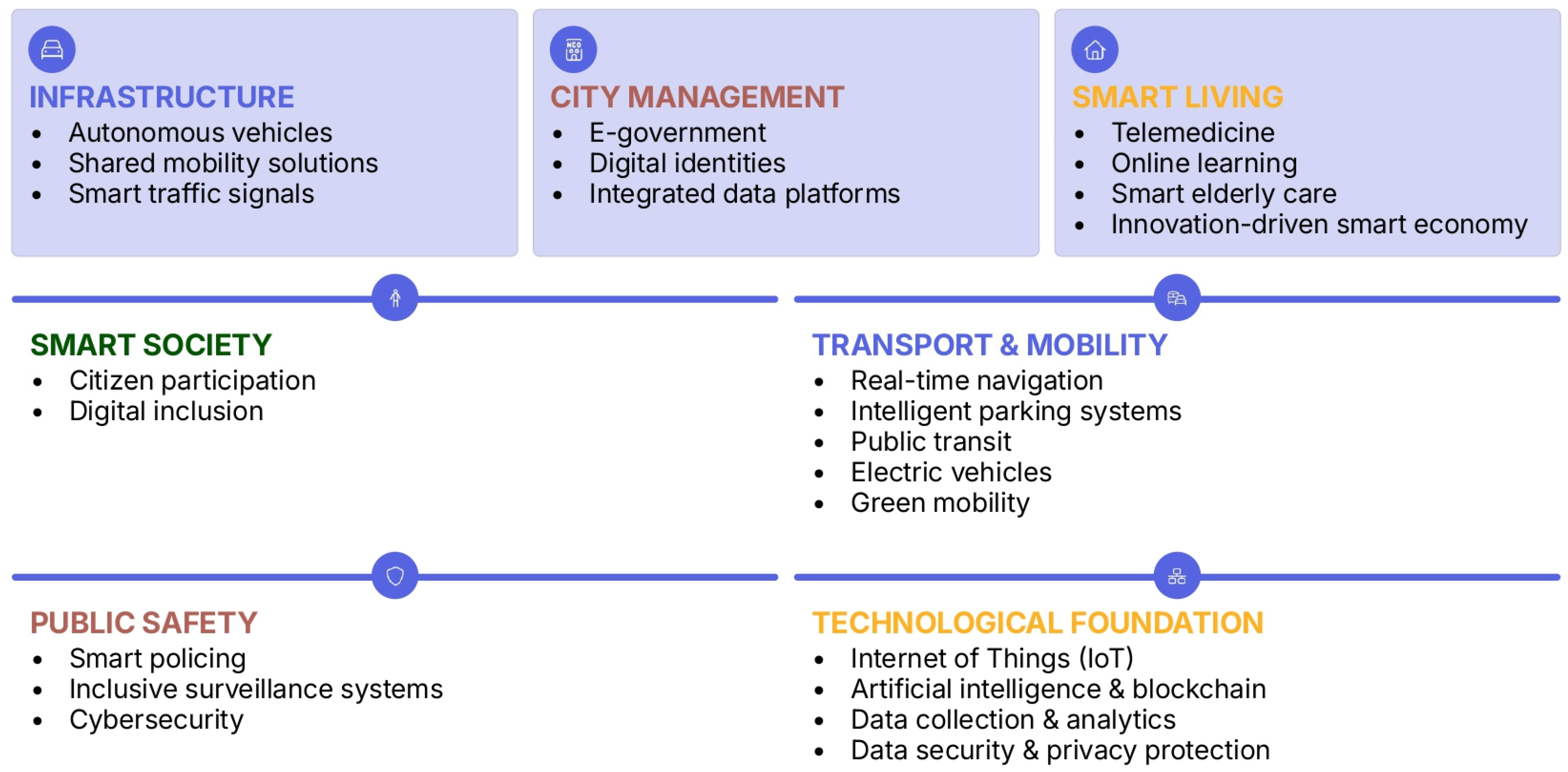
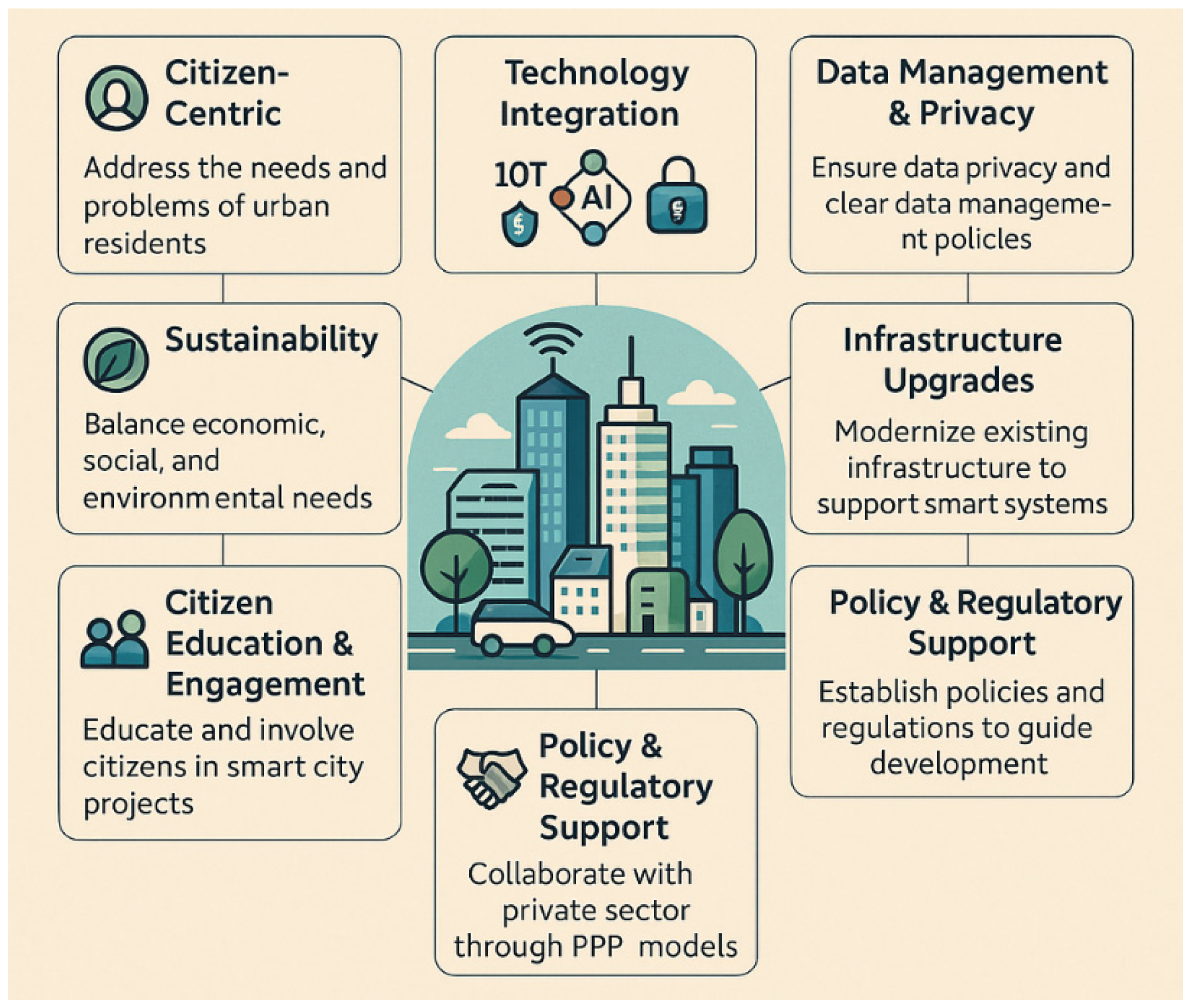
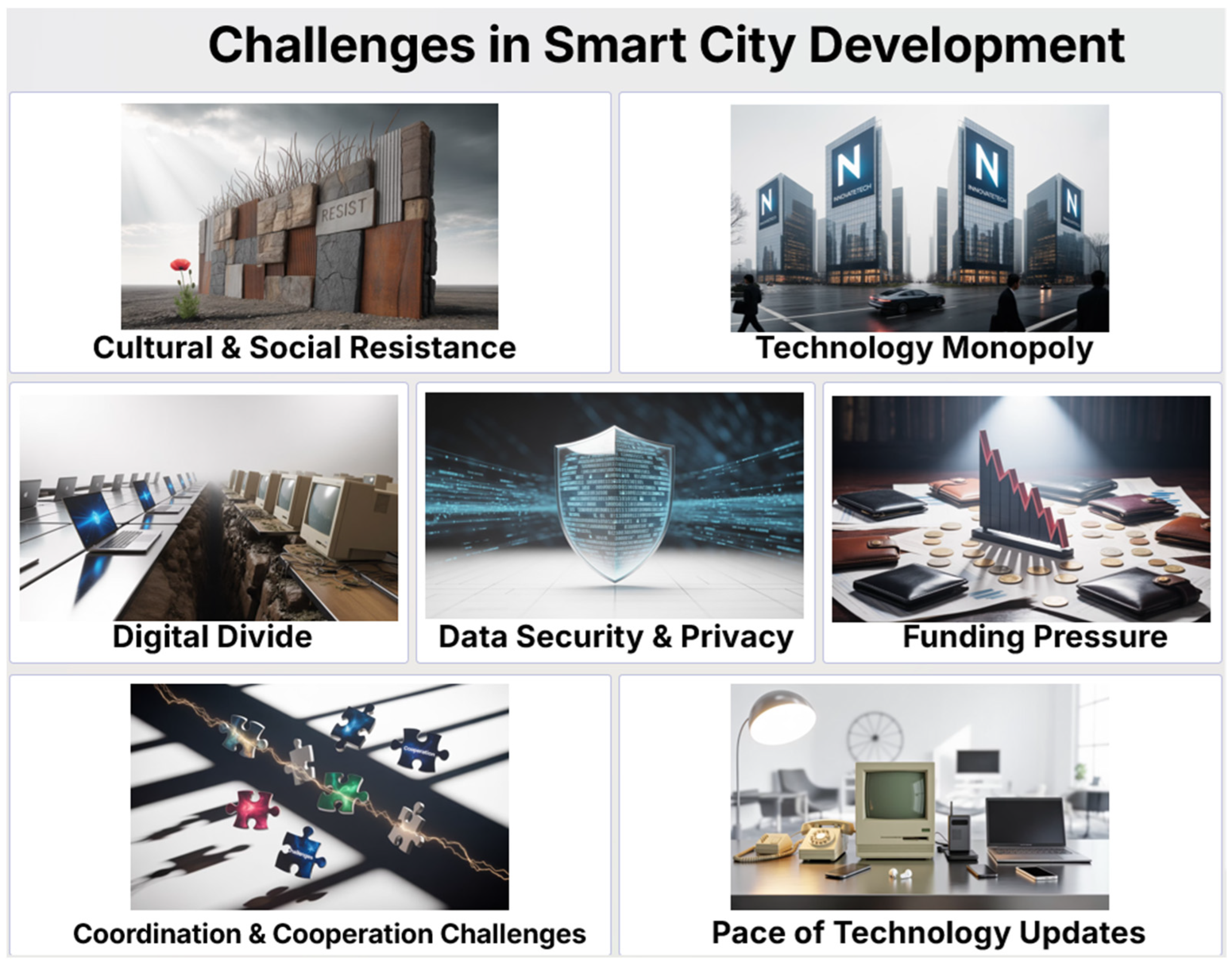

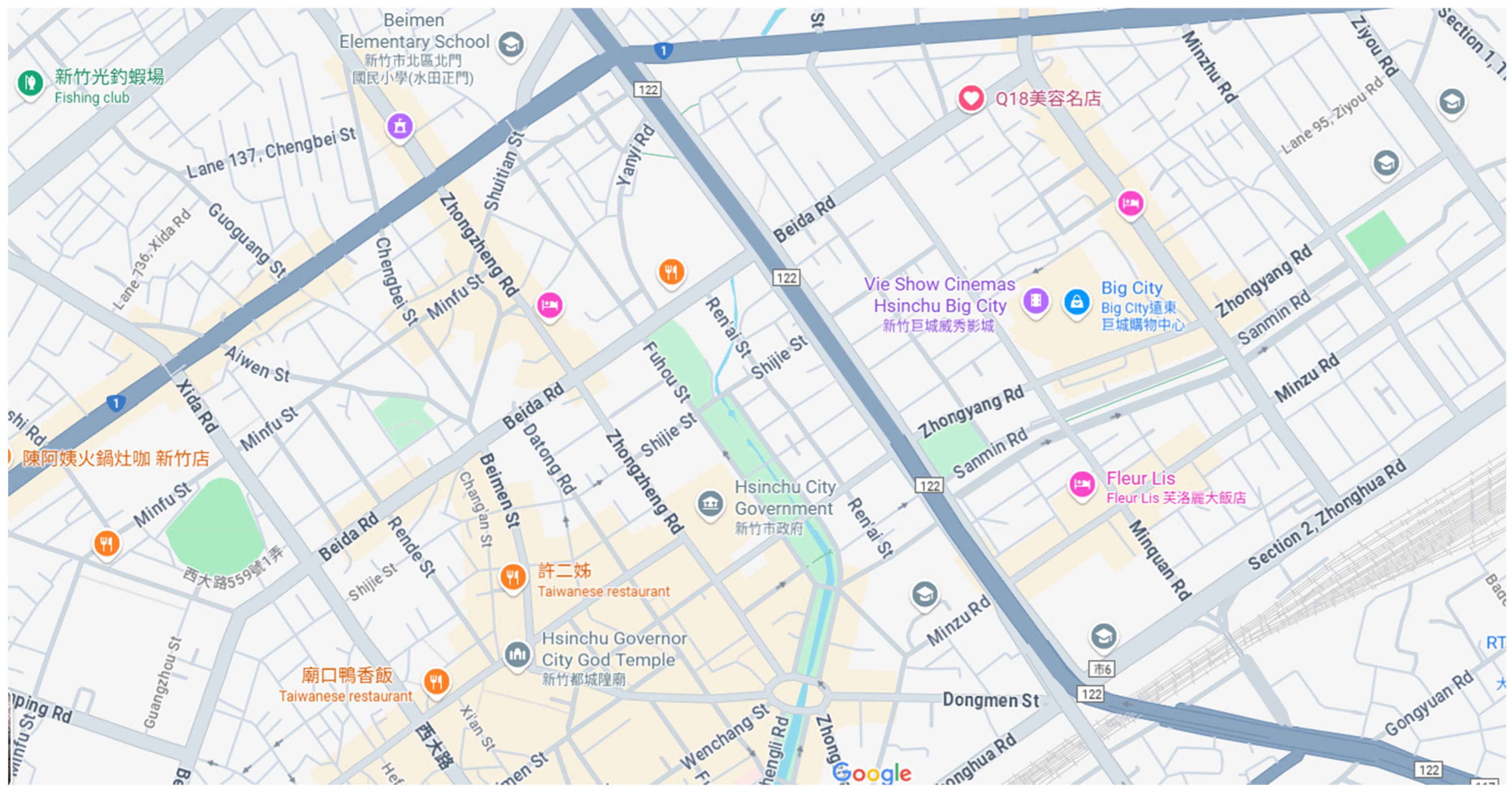
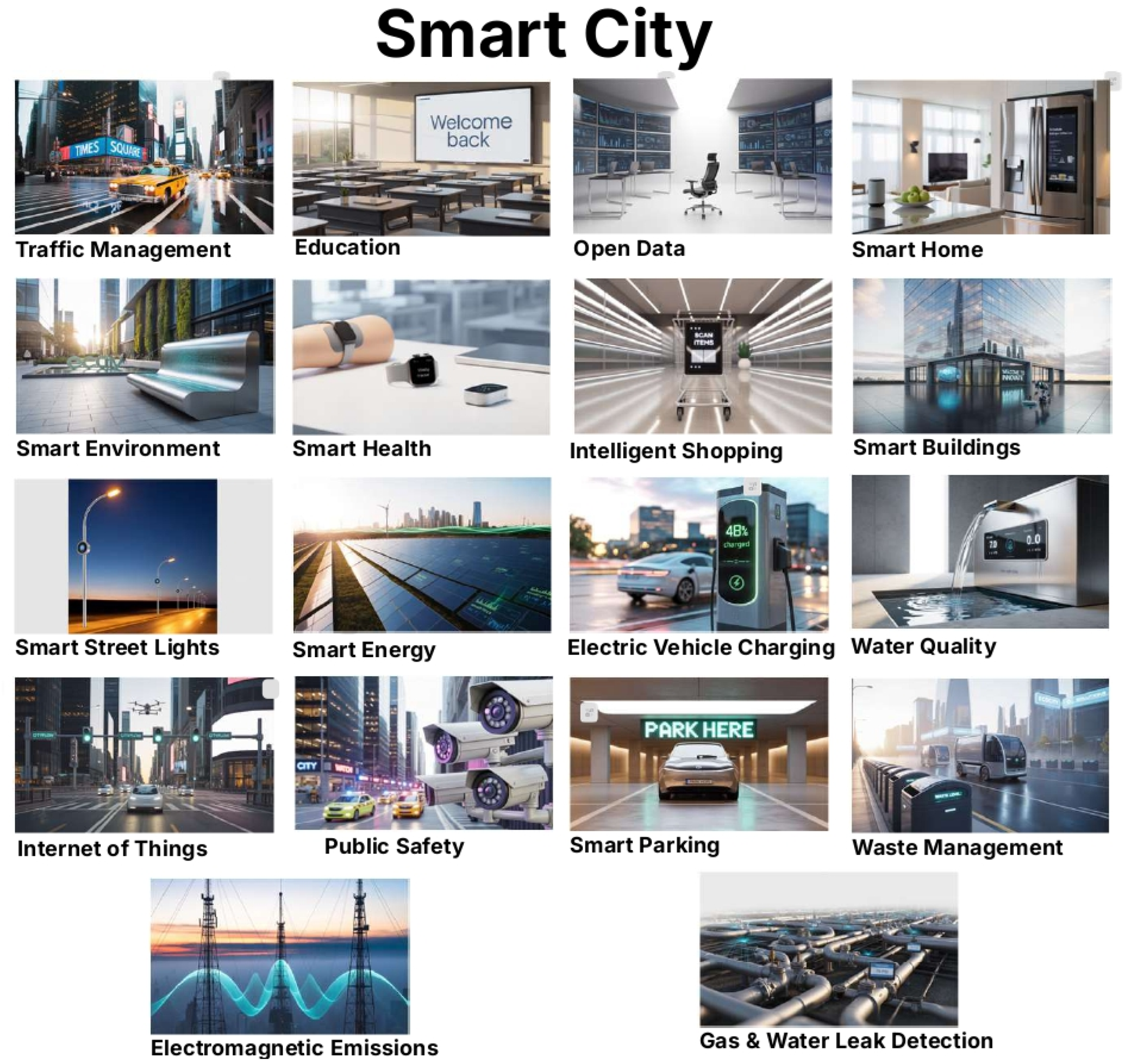
| Domain | Key Focus | Description |
|---|---|---|
| Smart Infrastructure Development | Digital and Intelligent Facilities | Deploy 5G, IoT, and sensors; implement smart traffic lights, parking systems, and waste management. |
| Smart Mobility and Transportation [25] | Integrated Transit and Data Coordination | Optimize public transit and walk/bike-friendly environments; use big data for traffic forecasting and flow management. |
| Smart Community Development | Intelligent Living and Governance Platforms | Promote smart homes and health management; build digital platforms for community governance and services. |
| Smart Energy and Environmental Management | Green Energy Integration and Real-Time Monitoring | Introduce renewable energy, smart grids, and building energy-saving technologies; deploy air and water quality monitoring systems. |
| Smart Economy and Innovation | Innovative Industries and Digital Economy | Develop AI and IoT industrial parks; promote e-payment, sharing economy, and innovation incubation. |
| Smart Governance and Participation | Data Platforms and Civic Engagement | Establish central city management platforms; enable citizen participation in governance via mobile apps. |
| Smart Education and Healthcare | Remote Learning and Smart Healthcare | Implement digital education, virtual classrooms, and telemedicine systems; integrate electronic health management. |
| Smart Security and Public Services | Intelligent Security and Integrated E-Governance | Deploy smart surveillance and disaster prevention systems; provide efficient online public services and resource allocation. |
| Sustainable Development Strategy | Carbon Neutrality and Circular Economy | Construct low-carbon new towns; promote resource recycling and smart waste management. |
| Resilient and Future-Oriented Design | Digital Twin and Modular Development | Apply modular design with space for future technology upgrades; strengthen new town adaptability. |
| Implementation Area | Key Strategies |
|---|---|
| Overall Planning and System Design | Define smart development goals, integrate urban systems, and set digital planning standards. |
| Smart Transportation | Build intelligent transportation systems, promote low-carbon mobility, and optimize transport using data. |
| Smart Energy and Infrastructure | Deploy smart grids, renewable energy, green buildings, and water resource management systems. |
| Smart Environment and Sustainability | Monitor environmental quality, implement smart waste management, and pursue carbon neutrality goals. |
| Smart Governance and Citizen Services | Develop e-governance, data-driven platforms, and strengthen channels for civic engagement. |
| Smart Economy and Industrial Development | Establish smart industrial clusters, support startups, and foster local digital economies. |
| Smart Education and Healthcare | Build smart campuses and remote healthcare systems, and integrate AI-based platforms. |
| Security and Emergency Management | Utilize AI surveillance, smart firefighting, and emergency response systems. |
| Digital Citizen Life | Provide inclusive digital services, smart housing, and virtual cultural facilities. |
| Future-Oriented Resilient Design | Adopt modular infrastructure and digital twin technologies for flexible planning. |
| City | Key Characteristics | Smart Technologies | Relevance to Hsinchu |
|---|---|---|---|
| Sejong City, South Korea | Planned as the new administrative capital; strong government investment | Smart traffic signals, integrated platforms | Policy-driven model of rapid growth |
| Singapore (Marina Bay) | High-density urban planning integrated with infrastructure | Internet of Things (IoT), Artificial Intelligence (AI), Smart grid | Compact and highly efficient land use planning |
| Amsterdam Smart City | Public–private partnerships; emphasis on sustainability | Energy monitoring, mobile applications | Civic engagement and green energy development |
| Zhongyang Road, Hsinchu | Smart upgrades implemented within traditional urban fabric | Smart streetlights, surveillance systems, 5G planning | Improving existing urban landscape with new technologies |
Disclaimer/Publisher’s Note: The statements, opinions and data contained in all publications are solely those of the individual author(s) and contributor(s) and not of MDPI and/or the editor(s). MDPI and/or the editor(s) disclaim responsibility for any injury to people or property resulting from any ideas, methods, instructions or products referred to in the content. |
© 2025 by the authors. Licensee MDPI, Basel, Switzerland. This article is an open access article distributed under the terms and conditions of the Creative Commons Attribution (CC BY) license (https://creativecommons.org/licenses/by/4.0/).
Share and Cite
Tuan, T.-C.; Chern, T.-Y.; Hsu, W.-L.; Shiau, Y.-C. Exploring the Application of Smart City Concepts in New Town Development: A Case Study of Zhongyang Road, Hsinchu City, Taiwan. Buildings 2025, 15, 3554. https://doi.org/10.3390/buildings15193554
Tuan T-C, Chern T-Y, Hsu W-L, Shiau Y-C. Exploring the Application of Smart City Concepts in New Town Development: A Case Study of Zhongyang Road, Hsinchu City, Taiwan. Buildings. 2025; 15(19):3554. https://doi.org/10.3390/buildings15193554
Chicago/Turabian StyleTuan, Ta-Chung, Tian-Yow Chern, Wei-Ling Hsu, and Yan-Chyuan Shiau. 2025. "Exploring the Application of Smart City Concepts in New Town Development: A Case Study of Zhongyang Road, Hsinchu City, Taiwan" Buildings 15, no. 19: 3554. https://doi.org/10.3390/buildings15193554
APA StyleTuan, T.-C., Chern, T.-Y., Hsu, W.-L., & Shiau, Y.-C. (2025). Exploring the Application of Smart City Concepts in New Town Development: A Case Study of Zhongyang Road, Hsinchu City, Taiwan. Buildings, 15(19), 3554. https://doi.org/10.3390/buildings15193554








